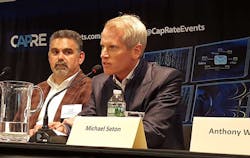Wall Street Gains Help Data Center Developers Build Bigger Clouds
NEW YORK, N.Y. – The data center industry’s winning track record on Wall Street will make it easier to finance future projects to drive the massive growth of cloud computing, according to industry CEOs and analysts. Investor enthusiasm for the cloud sector is also making it easier to fund acquisitions, accelerating the ongoing consolidation in the data center business.
Share prices for data center stocks have surged in recent months, with an average gain of nearly 20 percent during the first quarter of 2016. Data center developers have emerged as one of the best ways for investors to bet on the growth of cloud computing, offering a better “pure play” on the cloud than shares of cloud leaders Amazon, Google and Microsoft, whose share values are heavily influenced by non-cloud businesses.
“Data centers are at the intersection of technology and real estate,” said Jon Petersen, a vice president at Jefferies, who said the “seemingly insatiable demand” for cloud capacity has insulated the data center sector from the turbulence in the broader stock market.
Petersen was the keynote speaker at last week’s Fifth Annual New York Data Center Summit by CapRate Events, which focused on the investment and financing climate for the data center industry.
This success has made it easier for cloud builders to raise capital for new data center construction which can run from $100 million for a multi-tenant facility to as much as $1.5 billion for a cloud campus housing several buildings.
“I’ve never seen so many institutions interested in investing in the data center market,” said Todd Raymond, the CEO and Managing Director of 1547 Critical Systems Realty. “I’ve also never seen so many people who are familiar with the data center market and understand what we do.”
That familiarity is crucial to investors in real estate, where data centers compete for investment with developers of office buildings, shopping centers, apartment buildings and other established asset classes. Data centers now claim the stability of a real estate investment, while retaining the sexiness of a technology company.[clickToTweet tweet=”Data centers have the stability of a real estate investment and the sexiness of a technology company.” quote=”Data centers have the stability of a real estate investment and the sexiness of a technology company.”]
“The increasing comfort of the capital markets has had a great impact on lending capacity and cost of capital,” said Hunter Newby, the Chief Strategy Advisor for Netrality Properties. “It’s a blessing to not have to explain it.”
A Capital Conundrum
It wasn’t always that way. In 2000 Newby and Raymond sought out capital for a new company focused on providing connections between telecom tenants inside 60 Hudson Street in New York. That company was Telx, which was acquired last year by Digital Realty for $1.9 billion. Sixteen years ago, investors were reticent about funding the new venture.
“No one would give Telx money,” said Newby. “You wouldn’t believe it now.”
Netrality Chief Strategy Officer Hunter Newby (right) says the availability of capital for data center projects has improved dramatically in recent years. At left is Todd Aaron, the Co-President of Sentinel Data Centers. (Photo: Rich Miller)
Financing didn’t get any easier after the dot-com collapse, which led to bankruptcies and failures for major data center builders like Exodus and AboveNet. The debut of Digital Realty, the sector’s first publicly-held real estate investment trust (REIT), helped provide benchmarks for investors and made the case for investment in existing players with a track record. Access to capital has improved gradually over time.
“It’s changed dramatically over the last 5 years,” said Michael Seton, CEO of Carter Validus Mission Critical REIT. “When we started out in 2011, we couldn’t get a loan. It’s significantly easier to finance data centers today. The banks lend to data centers based on the credit (of the tenant).”
The Cloud Changes the Game
It’s hard to overstate the impact of cloud computing on the booming business for data center construction and leasing. IDC said Monday that spending on cloud infrastructure will hit $38.2 billion in 2016, an 18.9 percent jump from 2015. The research firm projects that cloud investment will grow 12.5 percent a year through 2020, representing $58 billion annually.[clickToTweet tweet=”IDC: Spending on cloud infrastructure will hit $38.2 billion in 2016, up 18% from 2015.” quote=”IDC: Spending on cloud infrastructure will hit $38.2 billion in 2016, up 18% from 2015.”]
Of that total, $24.4 billion is being spent in 2016 on public cloud infrastructure, with a major chunk of that supporting growth of cloud landlords leasing plug-n-play capacity to Microsoft, Facebook, Apple, LinkedIn, Twitter and Rackspace. Key beneficiaries include data center REITs like Digital Realty, DuPont Fabros Technology, Equinix, CyrusOne, CoreSite and QTS Realty.
Jon Petersen, an analyst at Jefferies, says share prices of data center REITs are near all-time highs. (Photo: Rich Miller)
“Over the last few years we’ve seen explosive growth among share prices for data center REITs,” said Jeffries’ Petersen. “All these data center REITs are currently trading at or near all-time highs.” Petersen noted that in a period of 20 percent annual growth in data center footprint, vacancy rates actually decreased slightly.
The cloud isn’t the only growth driver for the data center REITs, either. Petersen cited a convergence of technology trends that could all contribute to demand for infrastructure, including the growth of mobile devices and video traffic, Big Data, the Internet of Things, and data storage demand from regulated industries like healthcare and finance, who are required to store multiple copies of datasets for compliance purposes.
Strong Returns Boost Data Center REITs
Investors’ appetite for data center shares has made it easier for publicly-held companies to raise fund by selling additional common stock. In March, three data center REITs took this step, and all three offerings were oversubscribed due to strong demand:
- DuPont Fabros Technology (DFT) raised $287 million by selling 7.6 million shares of its common stock, included an underwriters option for 993,000 additional shares.
- CyrusOne (CONE) sold 6.9 million shares of stock, with underwriters expanding the offering by 900,000 shares due to strong demand.
- QTS Realty raised $240 million by selling 5.5 million shares of stock, with the offering being expanded by 500,0000 shares.
One reason data center stocks are in favor with real estate investors is that these properties offer an excellent rate of return on invested capital. This “cap rate” averages 15 percent for data center providers. That’s much higher than the return seen in other real estate asset classes. To illustrate, Petersen shared cap rates for three bellwether REITs in prominent asset classes:
- Equity Residential (apartment buildings) 7.4%
- Boston Properties (corporate office buildings) 8.1%
- Simon Property Group (regional malls) 12.1%
By comparison, leading data center REITs boast cap rates of between 10 percent and 18 percent, with four leading players (QTS Realty, CoreSite Realty, Equinix and CyrusOne) offering returns on invested capital of 15 percent or better.
Capital Creates Consolidation
Investor interest isn’t just helping finance construction of new data centers. It’s also funding acquisitions. There’s been a flurry of deals over the past year, and there are a lot of assets on the market, including properties owned by telecom companies hoping to shed poverhead and take advantage of attractive valuations of data centers. Executives in our latest Data Center Roundtable say they expect the acquisitions to continue, a view shared by many panelists at the New York Data Center Summit.
“One thing driving the consolidation in the data center industry is the availability of capital,” said Jeff Ferry, a director at Goldman Sachs with lengthy experience in the sector. “The expectation is that the returns will continue to be good. I think there’s still a lot of capital coming into the industry.”[clickToTweet tweet=”Analyst Jon Petersen: Data centers are at the intersection of technology and real estate.” quote=”Analyst Jon Petersen: Data centers are at the intersection of technology and real estate.”]
With strong competition in the leading markets, executives said much of the deal action has shifted to smaller cities. “You’ll see a lot more development in cities with less than half a million people,” said Raymond, the CEO of 1547.
“The financing is there,” said Andy Stewart, the Chief Strategy Officer at TierPoint, which has been one of the busiest buyers with 11 acquisitions in six years, primarily in secondary markets. “But it’s there to buy a building or business, not a greenfield (data center).”
Barriers to Entry Remain High
The many C-suite executives at the CapRate event agreed with Stewart that a track record is critical in attracting investment. Due to its capital-intensive nature, the data center industry has always presented high barriers to entry for new companies. That continues to be the case in the current environment, as investors are backing more companies, but remain disciplined and wary of the risk presented by new players.
Douglas Adams, the President of Raging Wire Data Centers, on a panel at the N.Y. Data Center Summit. (Photo: Rich Miller)
“It’s very difficult to start a new company in the space we’re in,” said Douglas Adams, President of RagingWire Data Centers.
That opinion is shared by the founder of one of the recent success stories for data center startups. Industry veteran Chris Crosby launched Compass Datacenters in 2011 to build dedicated data centers in second-tier markets.
“I wouldn’t have started Compass now,” said Crosby. “You can finance projects. But it’s not going to be easy to fund a platform company.”
The turbulence in the energy markets has also had an impact, spilling into the bond market. That’s one reason why there were no technology IPOs in the first quarter of 2016, the first time that’s happened since 2009.
Turbulence Still A Factor
Last September Carter Validus announced that it had hired Goldman Sachs to explore strategic alternatives. That process concluded in late November, with the company saying it would keep its options open.
“The fourth quarter of last year was very difficult and very volatile,” said Seton, the CEO of Carter Validus. “It was not a great time to be testing the market. The interest in our data center properties was very strong. We ultimately decided to stop the process because we felt we could probably hit the market at a better time.”
This year’s unpredictable presidential election may lead to additional market volatility, and could convince some companies to put off decisions on data center space. Jim Kerrigan, Managing Director of North American Data Centers, said he saw a noticeable dropoff in leasing activity prior to the 2012 election.
“The election is likely to slow down enterprise activity during next two quarters,” said Kerrigan.
About the Author



